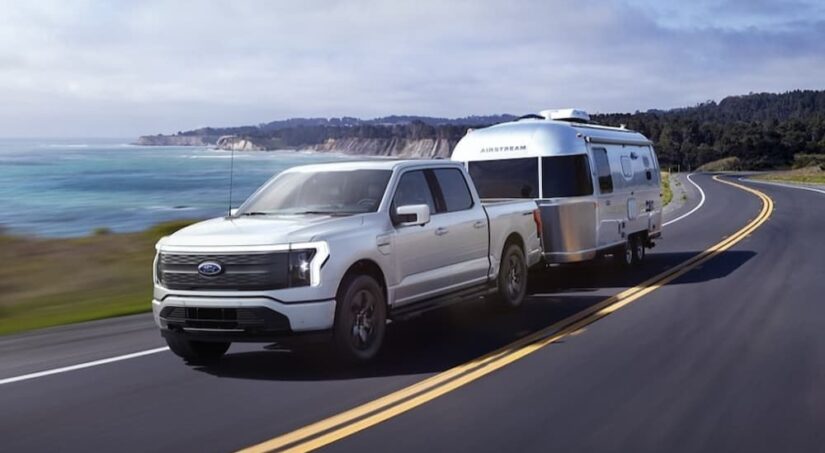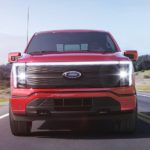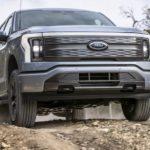When you picture an electric vehicle, the first thing that comes to mind probably isn’t a pickup truck. But electric trucks are popping up all over these days, being produced both by new startups like Rivian and established automakers like Ford. Ford has been making trucks for over a century now, so the company is no stranger to evolution. Over the years, Ford trucks have been improved in many ways, from the addition of technologies like air conditioning and modern safety systems to switching from an all-steel construction to a mix of high-strength steel and lightweight aluminum.
This willingness to innovate has certainly been a success. It’s difficult to find a dealership that doesn’t have a Ford F-150 for sale today since the truck has been a best-seller for decades now. But the introduction of the all-electric Ford F-150 Lightning has led many to wonder whether this EV pickup will be the latest step forward in the evolution of the Ford F-Series or simply a footnote in the company’s long history. However, despite the naysayers, the Lightning is shaping up to be the ideal light-duty pickup.

Lower Operating Costs
Every project is unique, but the desire to stay under budget is pretty much universal. Whether you’re a contractor trying to offer competitive prices or a homeowner cutting costs by doing your next renovation yourself, it’s best to save money whenever possible. While the F-150 Lightning is pricey up front, it gives you plenty of ways to cut costs over time.
It should come as no surprise that gas can be expensive. Fuel prices are unpredictable and can shoot up without much notice sometimes, making it a difficult expense to plan for in advance. And trucks aren’t exactly known for being fuel-efficient, so the average pickup can go through a lot of fuel in a year. With the F-150 Lightning, you don’t need to worry about prices at your local gas station. You can recharge at public charging stations or plug it in at home. Electricity prices tend to be less volatile than the cost of gasoline, making it easier to budget for in the long term.
Drivers can also look forward to spending less money each year on maintenance. EVs still need to go in for service now and then, but they tend to require less maintenance than gasoline or diesel vehicles for a variety of reasons. For one thing, they don’t have as many fluids as traditional engines, so you never need to get an oil change. There also aren’t as many moving parts that need to be kept aligned and lubricated. Further, the brakes don’t wear down as quickly because of regenerative braking, which takes the energy that normally is lost as heat with traditional mechanical brakes and converts it into power that can be used to charge the battery.
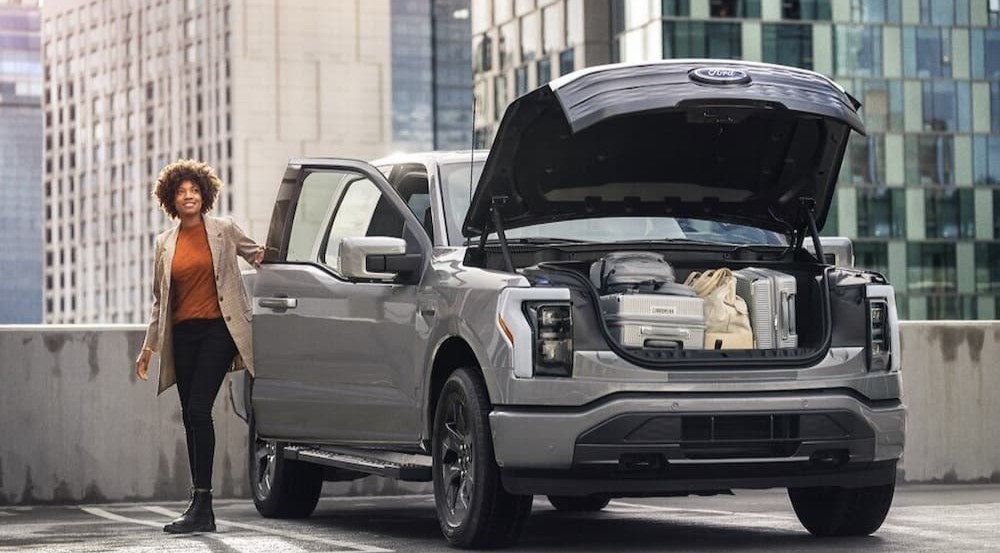
Tons of Torque
The simplicity of electric motors, when compared to gas and diesel engines, can also come in handy when you want to accelerate. When you look at an engine’s specifications, you’ll find two important figures: horsepower and torque. The difference between the two is a bit complicated, but basically, torque measures a vehicle’s ability to do work, while horsepower measures how quickly the vehicle can do it. Higher torque figures translate to more force, which comes in handy when towing and hauling a lot of weight.
But the figures generally listed by automakers are the maximum torque and horsepower. The force a vehicle actually puts out changes as the engine speeds up and slows down. For an internal combustion engine, you need to be in the right gear in order to get peak performance at a particular speed, and road conditions can also complicate matters. Automatic transmissions have been adding more and more gears over the years in order to help keep the engine in its powerband, but it’s still not perfect, especially when accelerating from a stop.
With an EV like the F-150 Lightning, you don’t have to worry about any of this and can enjoy maximum torque almost instantly instead of having to speed up to get to it. This means the Ford F-150 Lightning delivers all 775 lb-ft of torque as soon as your foot hits the pedal. That can come in handy when you need to accelerate quickly on the road, especially if you have a trailer in tow. It also comes in handy when driving at low speeds, like through a Home Depot parking lot or while delivering cargo to a busy worksite.
Pro Power Onboard
Trucks are great for towing trailers and hauling cargo, but those aren’t the only ways they can come in handy. When you’re at a work site, a truck’s bed can act as a mobile workbench, giving you a raised space that’s stable enough to support power tools. But those saws, drills, and heat guns aren’t going to be much use to you if you don’t have power for them. If your site doesn’t provide easy access to electricity, then you’ll have to bring along a generator, which can be heavy, noisy, and inconvenient.
With the F-150 Lightning, it’s easy to plug your tools right into the outlets located in the bed. While this feature is also available on the gas-powered F-150 and standard on hybrid models, the version that comes standard on the F-150 Lighting is more powerful, thanks to the EV’s high-capacity battery. Unlike other versions of the truck, the F-150 Lighting can be used to power an entire house for up to three days. That’s a lot of power onboard.
Ford’s Pro Power Onboard is essentially a generator that’s built right into the bed of the truck. With 11 plugs, including a 240V outlet in the bed, and 9.6 kW of power, you can plug everything into the F-150 Lightning and not have to worry about getting a generator or running an extension cord to the nearest source of electricity. That means less time working out logistics and more time getting down to business.
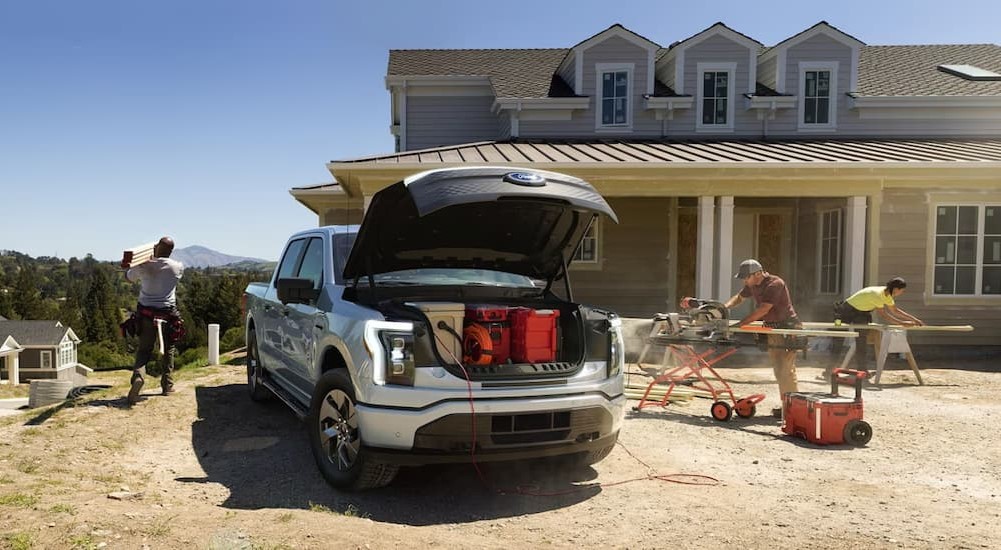
Extra Secure Storage
Since the all-electric F-150 Lightning doesn’t have an engine, the space under the hood is free real estate. Ford decided to use that space to give the Lightning a sealed front truck with 14.1 cu.ft. of cargo space, four 120V outlets, and a pair of USB ports. Workers with delicate and expensive equipment can store their gear in this “frunk” and know that it’s locked up tight, safe both from wandering eyes and from the whims of the elements. It is even power operated for easy access when your hands are full.
Sometimes, Different Is Better
There’s no denying that the F-150 Lightning is a different beast from its gas-powered counterpart. It can tow up to 10,000 lbs, but the gasoline F-150 can deliver up to 14,000 lbs with its 3.5L EcoBoost engine. The Lightning’s maximum payload capacity is impressive at 2,235 lbs, but not quite as high as the 3,315 lbs the normal F-150 can haul. However, if you’re only planning on doing light jobs and will never come close to needing the gas-powered F-150’s sky-high stats, then the unique benefits of the Lightning are pretty appealing.
You can recharge the Lightning just about anywhere you can find electricity and then bring that power wherever you go, from campsites to worksites. With the available extended-range battery, the Lightning can travel an estimated 320 miles between charges, which is plenty for contractors who are doing local jobs. On top of cheaper power and less maintenance, the switch to electricity also means more storage space and near-instant torque. If you can live with the Lightning’s performance stats, then you can take advantage of all that this futuristic pickup has to offer.
